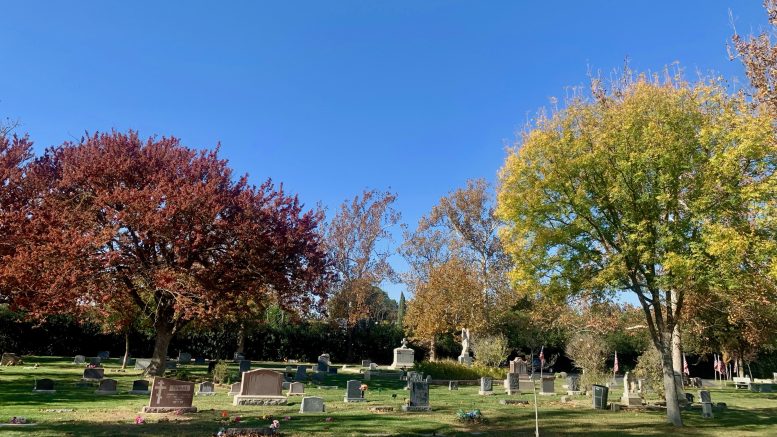The Chiles Mansion and what happened in 1972
By David Kulczyk
Over a decade ago, the heirs of Mary Simmons put 12 undeveloped acres of prime real estate on the market. The property next to the Davis Cemetery was quickly snatched up for $4.2 million by New Urban Development, LLC, a partnership between longtime Davis builders Steve Sherman and Dan Fouts. For one of the last undeveloped plots within the city limits, New Urban Development began planning to create a “green” housing subdivision aimed at moderate-income earners.
It looked like a happy ending for a plot of land where a 1972 crime shook Davis to its core.
Dr. Larry Z. McFarland was the 41-year-old chairman of the Department of Veterinary Anatomy at University of California, Davis. McFarland had worked his way through UC Davis by toiling as a janitor, eventually earning his degrees and professorship. Dr. McFarland was renowned for his research of the connection between the now-banned pesticide DDT and the thickness of bird eggshells. He was married to Sophia Simmons, a native of Czechoslovakia and a registered nurse. Over the years, the couple had three children, Kenneth, Michael and Nina. By all accounts, they appeared to be a happy family.
The McFarlands bought the Chiles Mansion on East Eigth Street next to the cemetery in the early 1960s, and the family spent a decade remodeling the two-story, nine-room, 85-year-old Victorian and surrounding property, creating 12 acres of park-like grounds in which their children would play with their menagerie of dogs, horses, ducks and doves. The McFarlands decorated their home with expensive antiques and heirlooms. The doctor spoke frequently to his colleagues about his happy family activities, but unknown to his friends and neighbors, all was not well at the McFarland home. The couple had separated, with Dr. McFarland moving into an apartment a dozen blocks away.
Sometime during the evening of April 7, 1972, Dr. McFarland bashed in the skulls of his 45-year-old wife and his three children. He dragged their bodies to the upstairs master bedroom and laid them side by side, face up on his bed. Nina was 9 and Kenneth was 10. Michael was at a school dance and was probably the last to be murdered when the 14-year-old came home sometime after 11 p.m.
McFarland locked the doors to the mansion, splashed gasoline across the first floor and ignited a blaze that took firemen 45 minutes to contain. The demented doctor was found sprawled across his family with his head blown off by the blast of a double-barreled, 20-gauge shotgun. A rambling two-page letter was found in his pickup truck with detailed instructions for funeral services and numbered and itemized instructions for the disposal of the estate. McFarland left no explanation to why he murdered his entire family other than that his family should remain together in life and death.
Sophia’s mother, Mary Simmons, refused to allow the doctor to be buried with his family and fought for ownership of the property. Once she gained title of the estate, she never set foot on it again.
Almost 36 years later, the Simmons property remained fallow. Abandoned vegetable and flower gardens littered the acreage like empty Big Gulp cups in a Little League dugout. The ancient, unpainted barn dominated the land like a Mayan pyramid. It was the only building in decent shape, nothing that a good cleaning wouldn’t fix. With stalls for horses and lofts for hay, it could have easily housed six grown horses. Rusting hitching posts throughout the acreage recalled a happier time, when soft rock songs like “A Horse With No Name” and “American Pie” ruled the Billboard charts. Only wild turkeys and jack rabbits live here now.
Half a dozen dilapidated outbuildings dotted the site. The ruins of extensive rabbit pens and chicken coops shared a sheep shed with a gaping hole in its roof. The once neatly landscaped shrubbery had grown into grotesque caricatures of itself.
A brace of gnarled California oaks that appeared as if they were sets from the flying monkey scene in The Wizard of Oz outlined the edges of the old house. The foot-thick top branches were still scorched from the tragic fire 35 years before.
As developers began to plan what they would do the old Chiles property remained the way that it had been for three and a half decades … overgrown and overlooked. Hundreds of people drove and walked by every day and never noticed the vacant lot with “No Trespassing” signs hanging on the gates, giving the impression that the land is part of the adjacent Davis Cemetery.
In a way, it was.
Tune in to SN&R’s crime section for more pieces like this.


I’m curious whether a photo of the intact house (pre-tragedy) exists?